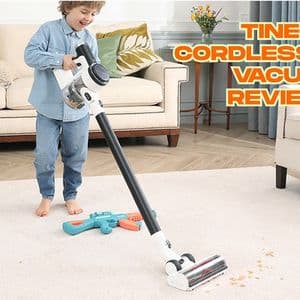Why Runtime Matters in a Cordless Vacuum
Cordless vacuums have become increasingly popular due to their lightweight design and wire-free operation. But the most common complaint among users?
Short battery life.
The runtime of a cordless vacuum determines how much cleaning you can do in one session without having to recharge. If your home is large or you regularly clean multiple areas at once, longer runtime isn't a luxury—it’s a necessity.
Understanding Vacuum Runtime: What’s Behind the Numbers?
You’ve seen it before—product listings boasting 60, 80, even 100 minutes of runtime. But what do those numbers actually mean?
Here’s the catch:
Most advertised runtimes refer to the vacuum’s lowest power setting, which usually doesn’t reflect typical daily use. In real-world conditions—using the standard or high-power setting with a motorized brush head—actual runtime can drop significantly.
Battery Type
Most cordless vacuums use either:
-
Lithium-ion batteries: Known for consistent performance and fast charging.
-
Nickel-metal hydride batteries: Less common, heavier, and slower to charge.
Lithium-ion batteries dominate the longest running models because they hold a charge longer and degrade more slowly over time.
Power Modes and Attachments
Using high suction mode or power-intensive tools like a rotating brush can reduce battery life by half or more. So, a vacuum rated at 80 minutes may only last 35 minutes in normal use.
Characteristics of the Longest Running Cordless Vacuums
Let’s unpack what makes certain models outlast the rest.
High-Capacity Battery Packs
Models with swappable or dual battery packs can offer runtimes of over 90 minutes when used sequentially. This feature is especially useful in cordless stick vacuums with removable battery designs, where one battery can be charging while the other is in use.
Smart Power Management
Advanced vacuums include smart sensors to adjust suction power based on floor type or dirt level. By dynamically changing the power output, these vacuums extend battery life without sacrificing cleaning performance.
Efficient Motor Design
Brushless digital motors run cooler and more efficiently, translating into longer operation times. They also tend to be more durable and require less maintenance.
Average Runtimes by Category
So, how do different cordless vacuums compare?
| Type of Cordless Vacuum | Average Runtime (Standard Mode) |
|---|---|
| Handheld-only | 15–30 minutes |
| Cordless stick (single battery) | 30–60 minutes |
| Cordless stick (dual battery) | 70–100+ minutes |
| Robot vacuums (for comparison) | 60–120 minutes |
If you’re looking for the longest operation on a single charge, dual-battery cordless stick vacuums are usually the best bet.
Real-World Considerations Beyond Runtime
Battery life is only one piece of the puzzle. Here are a few other things to think about:
Recharge Time
Long runtime is great—but not if you need to wait 6 hours to recharge. The best cordless models often recharge in 3–4 hours. Some even offer fast-charging stations or removable batteries that can be charged separately.
Weight and Maneuverability
A vacuum that runs for 90 minutes but causes arm fatigue after 10 isn’t helpful. Look for lightweight builds and well-balanced designs that are comfortable to use for extended sessions.
Dustbin Size
Longer runtimes mean more dust collected. A small bin will require frequent emptying, breaking your cleaning flow.
Read more: Vacuum Stick Cleaners
Who Needs a Long Runtime Vacuum?
Not everyone needs the longest runtime available. But here are scenarios where it really pays off:
-
Large homes: Multiple rooms and levels require extended sessions.
-
Pet owners: Frequent cleaning is necessary due to hair and dander.
-
Busy households: One long clean is more efficient than several short ones.
-
Limited outlets: If you can’t charge often or prefer to clean in one go.
Common Myths About Cordless Vacuum Runtime
Let’s clear up a few misconceptions:
“More runtime always means better performance.”
Not necessarily. A longer-lasting vacuum that has poor suction won’t clean well, no matter how long it runs.
“All advertised runtimes are accurate.”
As mentioned earlier, most manufacturers report the maximum runtime under ideal (and unrealistic) conditions. Always look for third-party data or real-world performance estimates.
“Cordless vacuums can’t match corded models.”
While runtime was a barrier in the past, many high-end models now rival corded vacuums in both suction power and durability—especially in premium brands often mentioned in a typical vacuum cleaner dyson review.
Tips to Maximize Runtime on Your Cordless Vacuum
Want to get the most out of your vacuum’s battery? Try these:
Use the Right Power Mode
Avoid using high power unnecessarily. Standard mode is often sufficient for regular debris.
Maintain the Filters
Dirty filters reduce airflow and efficiency, draining the battery faster.
Store Battery Properly
Avoid storing the vacuum in extremely hot or cold environments. Temperature extremes degrade battery life over time.
Fully Charge Before First Use
Initial charging conditions can affect long-term battery health.
Future Trends in Cordless Vacuum Runtime
The market is evolving fast. Here’s what’s coming:
Solid-State Batteries
These next-gen batteries promise faster charging, greater capacity, and longer lifespan—all in a smaller package.
Smarter Energy Allocation
AI-driven suction adjustment, learning cleaning patterns, and mapping high-traffic areas will allow vacuums to clean more efficiently, conserving battery life.
Integrated Battery Monitors
More models will likely feature real-time runtime displays and smart notifications, helping users plan better.
Final Thoughts
The longest running cordless vacuum isn’t defined by a single number—it’s the result of battery design, suction efficiency, and smart power use. Whether you're cleaning a spacious home or trying to make fewer trips back to the charger, understanding these factors will help you make the right decision.
And remember: even with longer runtime, proper care and use make a big difference. Optimize your habits, and your vacuum will return the favor—every time you press that power button.










